#poisawan
Explore tagged Tumblr posts
Text
The weird and wonderful history of Kowloon as a digital interactive space - Part II
This article is the continuation of a previous post.
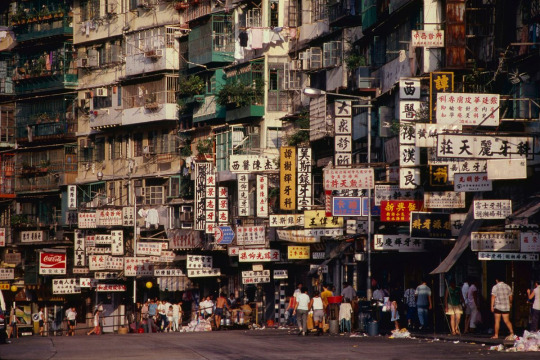
Any comprehensive history of 20th century Hong Kong is not complete without a chapter entirely dedicated to the architectural and urban planning puzzle that was Kowloon Walled City. Quite unlike any other slum in Asia or elsewhere in the world, the extreme conditions under which its inhabitants lived captured the attention of various international journalists and photographers whose reports of this accidental labyrinth, in turn, inspired some of the most remarkable artistic explorations of our time. In this regard, video games did not remain impervious to the powerfully stimulative imagery, as much a reference today as it was when its hardened concrete walls still stood tall.
Kowloon's Gate Suzaku VR - Jetman - 2017
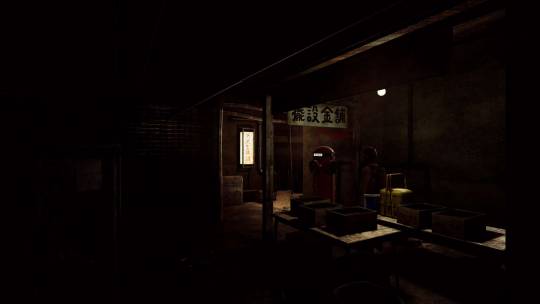
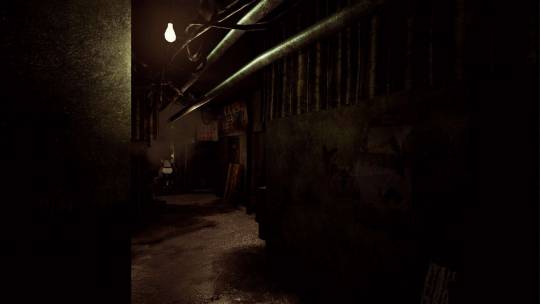
Kowloon's Gate made a most unexpected comeback twenty years after the original episode via the crowdfunded VR project Suzaku developed by Jetman, a studio founded by and composed almost exclusively of ex-SME/Zeque staff. While it is not the remaster many had hoped for, essentially consisting of a walking simulation through some redesigned locations from the original, it does a commendable job in faithfully replicating its instantly recognizable, light-starved alleyways in competent high-definition. It is also the only VR-compatible entry from this list, granting it a degree of uniqueness over its counterparts.
Stranglehold - Midway/Tiger Hill Productions - 2007
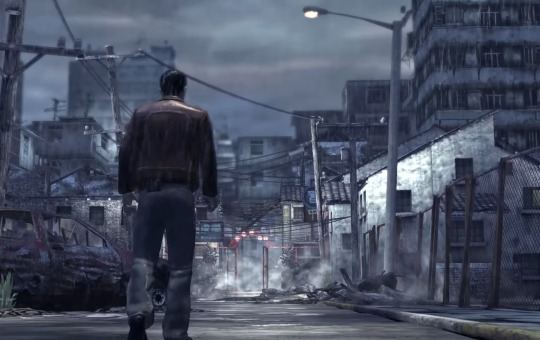
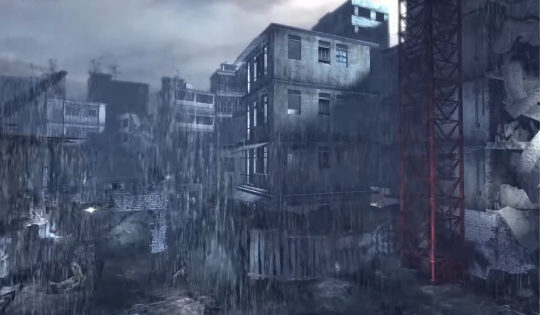
Stranglehold is the result of a collaboration with Hong Kong movie director John Woo, developed as a direct sequel to his heroic bloodshed classic Hard Boiled, featuring Chow Yun-fat in the role of detective 'Tequilla' Yuen in his unending confrontations with organized crime. One of the game's most unforgettable levels, Slums of Kowloon, takes place during a particularly rainy day, seemingly in those last days when the zone had been emptied of residents and demolition work was well underway. The visual representation of the quarter is suitably evocative, its buildings in complete state of disrepair, the remnants of local businesses or places of prayer still discernible from under the piles of steel and cement rubble.
Resident Evil 6 - Capcom - 2012
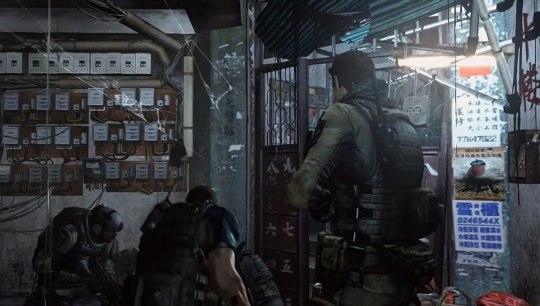
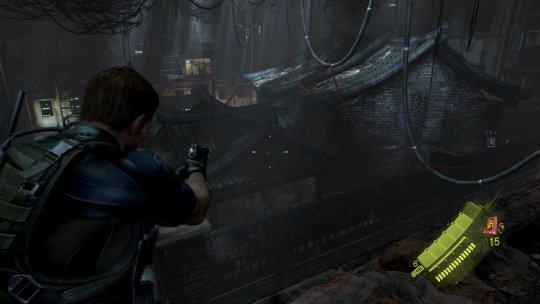
For all its shortcomings, Resident Evil 6 partly succeeds in taking the first two episodes' concept of parallel storylines and realizing it to a much fuller extent. Its choice of different characters translates into entirely different campaigns, locations and playing styles. The very first scene in Chris/Piers' campaign occurs in the fictional Chinese city of Lanshiang, modelled after real-life Hong Kong. The mayhem in the main streets forces the player to take a detour into a location named Poisawan, which bears a striking resemblance to the Kowloon district. Though an unofficial representation, it is among the most skilled replications of the scenery we find in the vast photographic repository of the area. The degree of minutiae with which the district's haphazard electric installation is replicated, alone, suffices to demonstrate a true commitment to authenticity.
Paranormal HK - Ghostpie Studio - 2020


Few would dispute that Kowloon is, itself, naturally conducive to sentiments of dread and anxiety. Paranormal HK is a 2020 made in China production reviving the defunct neighbourhood in a gripping, blood-curdling contemporary ghost story. The player is the cameraman of a paranormal-themed TV show exploring the zone during the evening of the Zhongyuan festival, a scheme suspiciously akin to that of Akira Ueda's 2004 game, Michigan: Report From Hell. As a result of the thorough research work performed by its creators, as well as the impeccable usage of contemporary 3D graphics techniques to achieve accurate lighting conditions, players may momentarily experience the feeling of walking into a photo of the actual city as it existed in the mid eighties.
Sifu - Sloclap - 2022
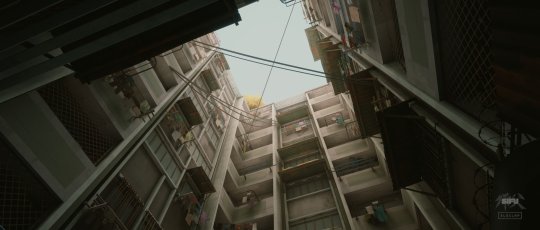
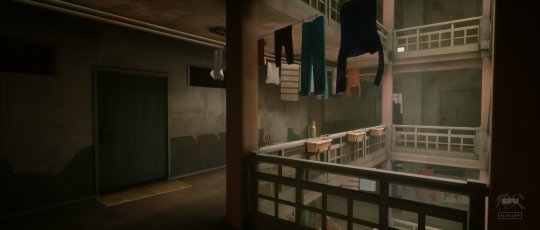

Notwithstanding of its renaissance during the 128-Bit era, the beat 'em up genre is commonly associated with the arcade games of the late 80s and 90s, the period of time when it flourished and, arguably, reached its zenith. The simplicity of controls and ease of access sufficed to attract players to the arcade cabinet, while the frequently extreme levels of difficulty of advanced levels ensured a steady flow of cash for arcade room owners and game development companies alike. Nevertheless, the genre has but perished and, in many aspects, recent years have indeed elevated it to unforeseeable degrees of complexity. Sifu, by Sloclap, synthesizes the elation of digital hand to hand combat simulation with the real-life complexity of mastering a martial art.
As is the case of previous entries in this list, Sifu makes no admitted reference to Kowloon or Hong Kong. However, the designers left little to the imagination in what pertains to their inspirations when taking on the task of constructing the game's environments. Another notable coincidence stems from the fact that this production was made possibly with the support from a celebrated independent game funding group going by the name Kowloon Nights.
Stray - BlueTwelve Studio - 2022


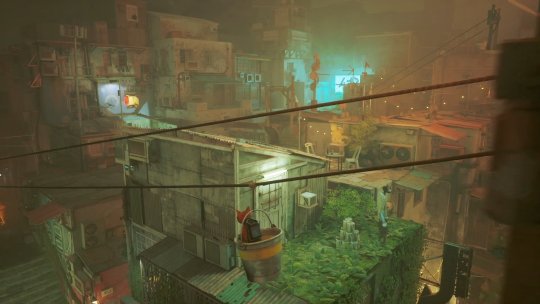
Stray is one of the most revered independent video games in recent memory, and justifiably so. The long development process yielded many benefits, judging from the consistency and attention to detail that engrossed many an avid player. That the main character is singularly charming feline may have played an equally crucial role. The creators have made no effort to conceal the fact that the notorious Hong Kong district was a pivotal influence to the design of its nameless city. The first indication can be spotted in the game's earliest footage, in which a black cat traverses a street where a particularly conspicuous sign boasted the initials HK. Stray is less concerned with presenting a precise replica of Kowloon than it is about summoning the very essence of its atmosphere. Moreover, in an exquisitely poignant way, its ending lends an entirely new meaning to the term walled city. In the future, robots may well take the place of humans. Invariably, the Walled City is no more. Slitterhead - Bokeh Game Studio - Work in Progress
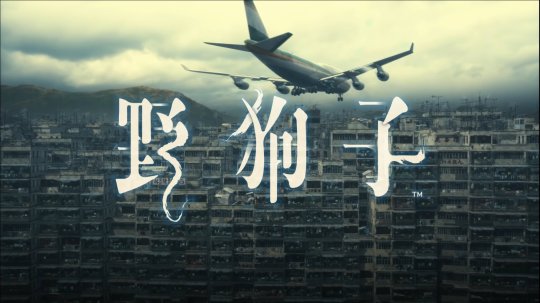

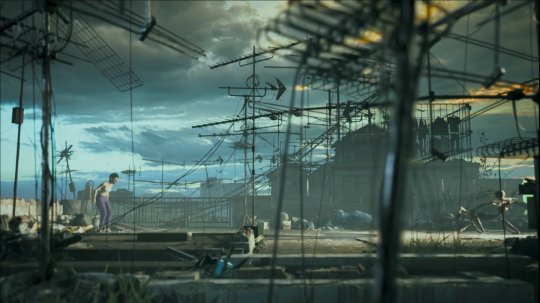
An sequence of unconscionable mistakes from the part of Sony Computer Entertainment's management galvanized Keiichiro Toyama to part ways with Japan Studio, as it once was, and establish his own game production label. Their debut title, Slitterhead, is described as a grotesque survival horror experience, a genre within which the author moves with matchless ease. Among the few certainties regarding this project is the fact that it will take place prominently - if not exclusively - within the Kowloon City province. A wide variety of aspects included in the preview footage leave the viewer optimistic as to this being one of the most accomplished portrayals of the district ever seen in a video game. Subtle yet telling signs already demonstrate the creator's in-depth knowledge of the quarter's architecture and history. Take, for instance, the suggestive image of the airplane flying mere meters above the top of the buildings. Although the growth of Kowloon was for the most part ungoverned, buildings did not rise above a certain height, even as inhabitants claimed for increased availability of space. This is due to the fact that airplanes landing at the nearby airport would be required to make their descent at relatively low altitude, performing a tight curve as they soared just above the enclave, thus preventing construction from expanding upwards. Another scene shows a child playing on the rooftops of the buildings, which once again is consistent with the documented habits of residents who, starved for sunlight and open space elsewhere within the city limits, had little alternative than to take the stairs all the way to the top.
Warehouse Kawasaki Arcade
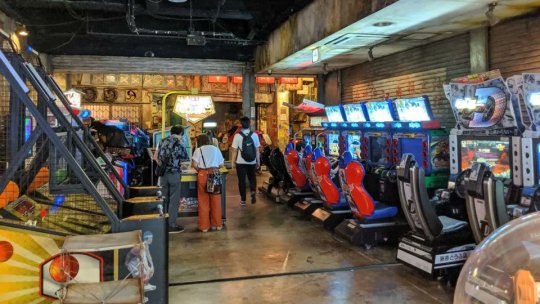
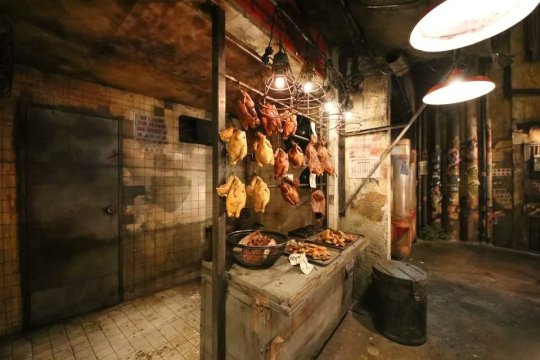
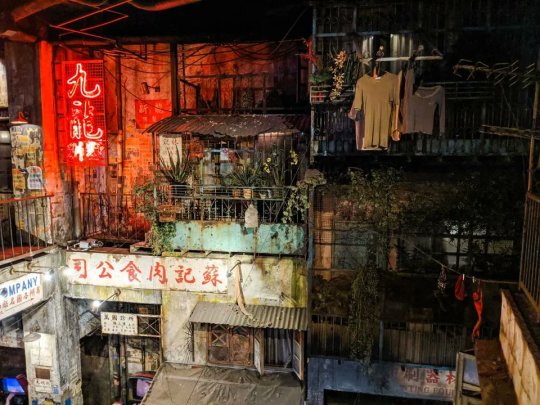
I would be remiss not to make some form of allusion to Warehouse Kawasaki, an arcade built to replicate the Walled City with unthinkable detail. Though its ultimate purpose was for visitors to engage in digital entertainment, the venue was scrupulously put together. Point in fact, many of the objects used in the construction of the five floor amusement centre were imported directly from Hong Kong. Like so many other Japanese arcades, it closed its doors in 2019.
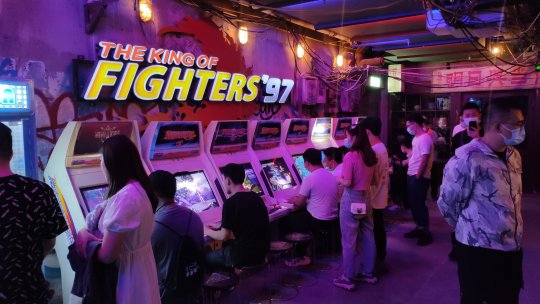
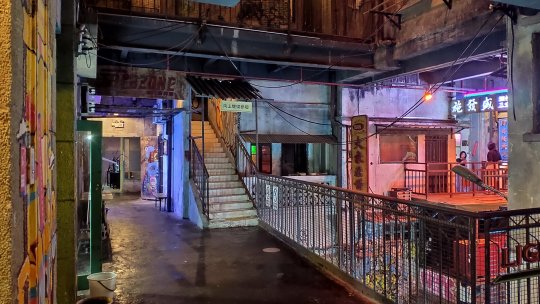
In recent years, a rather similar initiative was taken by the Chinese in their attempts to build unique mall spaces. The 文和友 malls in mainland China, found in Changsha, Guangzhou and Shenzhen, attempt to reproduce the walled city aesthetic. Local residents inform me that these are increasingly lacking in foot traffic, for which reason the majority of their stores are closed. Other digital replicas of Kowloon
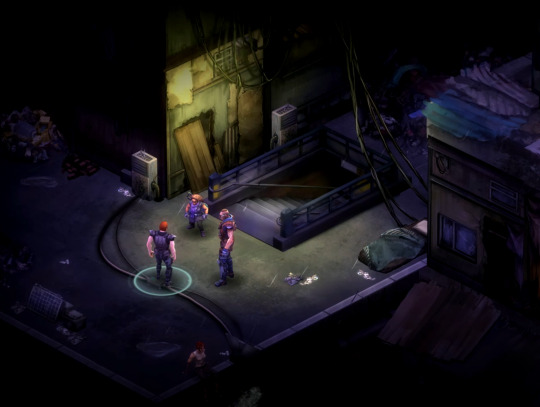
A number of other videogames set in or deriving inspiration from Kowloon could not be featured in this article. A frequently cited reference in this context is the action/adventure game Fear Effect, one which I emphatically dispute. No doubt remains as to it being located in a futuristic version of Hong Kong, yet I could discern no parallels with the walled city, save for those scattered second-hand visual motifs that were no doubt imported from sci-fi classics such as Blade Runner or Ghost in the Shell.
The Utelek Complex stage of Deus Ex: Makind Divided presents a similar situation, where the overall atmosphere of the futuristic favela bears some resemblance to Kowloon, without meeting the specificity quota that would warrant a more comprehensive exploration.
The 2004 Shout! original Kowloon High-School Chronicle for the PS2 is a unique case, in that it borrows the city's name despite taking place in a massive, Tokyo underground dungeon that is later revealed to be a maze-like Egyptian pyramid. The odd choice of title remains unclear. Shadowrun: Hong Kong game (screenshot above) contains a very direct mention of Kowloon as the place in which an entire episode comes to pass. Another project still in development, Kowloon's Curse (screenshot below), is following the lead of many popular independent horror games in recent memory by using a visual design and structure that elicits memories of the late Playstation/early Dreamcast era. A short prequel episode was made available earlier this year, for free.
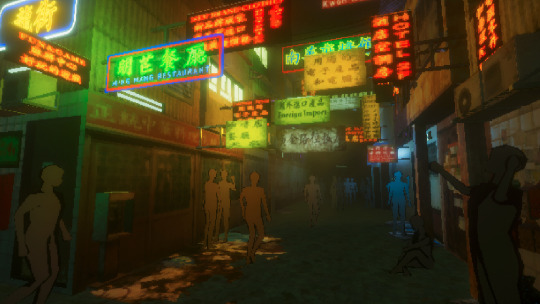
Additionally, I refrained from mentioning the Kowloon maps in Call of Duty: Black Ops or Counter-Strike: Global Offensive, as I perceive both games to be insufficiently relevant to merit study or contemplation.
A space that refuses to be forgotten
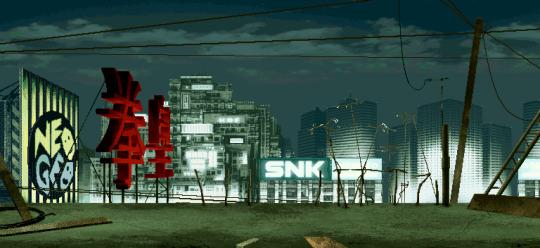
(China rooftop stage from The King of Fighters 2003)
It would be a gross overstatement to claim that Kowloon is a recurring location or level design motif in videogames. The relationship between digital games and the real life ghetto has been one of sporadic references. What makes the subject so engrossing pertains to the quality of the relationship, particularly that of a small cadre from among the titles featured in this article. Kowloon's Gate was one of the most relevant game creations of the 32-Bit era, a game deserving of reverence and cult following inside and outside Japan. Likewise, Shenmue II is the second instalment of a truly ground-breaking and highly advertised series whose production costs alone were unmatched until quite recently.
Moreover, this is an affair that is far from concluded. The unexpectedly high number of allusions to Kowloon in videogames released or revealed just last yet demonstrates that its aesthetic is still very much present in the minds and hearts of artists and designers working in the field. The walled city lives on as a digital demarcation that is certain to resurface time and again in years to come.
#kowloon's gate#kowloon's gate VR suzaku#jetman#stranglehold#john woo#kowloon walled city#hong kong#resident evil 6#poisawan#paranormal hk#ghostpie studio#sifu#kowloon nights#stray#slitterhead#bokeh game studio#keiichiro toyama#Warehouse Kawasaki#arcade#文和友
202 notes
·
View notes
Text










The Poisawan Street of Bin in Resident Evil 6 (2012)
#crimson's gifs: resident evil#Resident Evil#RE#Resident Evil 6#RE6#Resident Evil Scenery#RE Scenery#Ada's Campaign#Ada Chapter 3
8 notes
·
View notes
Text










The Poisawan Tenement & Courtyard in Resident Evil 6 (2012)
#crimson's gifs: resident evil#Resident Evil#RE#Resident Evil 6#RE6#Resident Evil Scenery#RE Scenery#Chris' Campaign#Jake's Campaign#Chris Chapter 3#Jake Chapter 4
8 notes
·
View notes
Text










The Small Town of Poisawan in Resident Evil 6 (2012)
#crimson's gifs: resident evil#Resident Evil#RE#Resident Evil 6#RE6#RE Scenery#Resident Evil Scenery#Chris' Campaign#Chris Chapter 1
8 notes
·
View notes
Text










The Poisawan Market in Resident Evil 6 (2012)
#crimson's gifs: resident evil#Resident Evil#RE#Resident Evil 6#RE6#Resident Evil Scenery#RE Scenery#Leon's Campaign#Leon Chapter 4
7 notes
·
View notes
Text










The Poisawan Stilt Housing Area in Resident Evil 6 (2012)
#crimson's gifs: resident evil#Resident Evil#RE#Resident Evil 6#RE6#Resident Evil Scenery#RE Scenery#Ada's Campaign#Jake's Campaign#Jake Chapter 4#Ada Chapter 3
6 notes
·
View notes
Text










The Poisawan Shopping District in Resident Evil 6 (2012)
#crimson's gifs: resident evil#Resident Evil#RE#Resident Evil 6#RE6#Resident Evil Scenery#RE Scenery#Jake's Campaign#Jake Chapter 4
5 notes
·
View notes
Text










The Poisawan Stilt Housing Area in Resident Evil 6 (2012)
#crimson's gifs: resident evil#Resident Evil#RE#Resident Evil 6#RE6#Resident Evil Scenery#RE Scenery#Chris' Campaign#Chris Chapter 3
5 notes
·
View notes
Text










The Poisawan Inner Area in Resident Evil 6 (2012)
#crimson's gifs: resident evil#Resident Evil#RE#Resident Evil 6#RE6#Resident Evil Scenery#RE Scenery#Chris' Campaign#Chris Chapter 3#I feel like most of Chris' Campaign Scenery is wasted on how rushed through his story is#Chris hatred aside you literally spend like 5 seconds in each location of his army sim 5000 and yet#if they added these locations to Leon/Jake/Ada's campaigns you know damn well theyd be better appreciated by the story#reason 18282828 why I think RE6 wouldn't have been worse off if they just dropped Chris' campaign completely
5 notes
·
View notes
Text










The Small Town of Poisawan in Resident Evil 6 (2012)
#crimson's gifs: resident evil#Resident Evil#RE#Resident Evil 6#RE6#Resident Evil Scenery#RE Scenery#Chris' Campaign#Swallowing my pride and playing through Chris' campaign for this shit and its just as boring and stupid as it was the first time#Hate his campaign so much. These set pieces are mostly wasted on him#Chris Chapter 1
6 notes
·
View notes